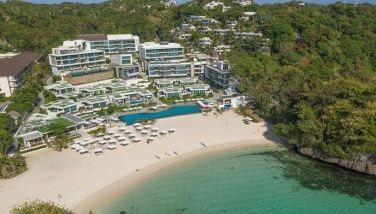‘Prosperity of the desert countries’

I am taking a vacation, and along with this vacation is my choice of topics.
On my way to this vacation, I spent two highly packed touristic days through one of the typical prosperous countries in the Middle East -- Qatar.
I was fortunate to be accompanied by my older son, Hans, on this trip. This was very helpful as I had the advantage of having by my side an experienced traveler who is himself a perceptive observer. Though I have had an extensive visit to many countries during my lifetime, Hans had worked and visited many more countries than I during his career as a man of business working on investment banking and finance.
We had wonderful exchanges of experience on travels such as this. We could compare observations, countries, and take them in their proper context. The Middle East is a very complex set of countries to evaluate.
AFTER THE OIL EMBARGO OF THE 1970s. The oil embargo that OPEC (Organization of Oil Exporting Countries) initiated on oil-importing nations in 1973 was led by Saudi Arabia. That historical moment was caused by the Gulf War of 1973 between Israel and the Arab nations in the region.
Before the 1970s, the price of oil per barrel was below $2. After the mid-1970s, the price of oil rose in great multiples. At its peak, the per barrel cost was $147 in 2008 (July).
In 2023, the average per barrel of oil was $82. The price could have been much higher except for many factors.
The rise of energy prices has made many producers of oil very economically rich and prosperous. Yet, the rise in crude oil prices also induced many new oil discoveries in other parts of the world to be undertaken. But despite it all, the center of gravity of oil and energy production is still in the Middle East.
The prosperous middle eastern countries.
The large amount of oil revenues that had been recycled back as investments into the national economies of many oil-exporting countries in the Middle East have been enormous.
Slowly and surely, as the investments accumulated over the decades, the level of gross domestic production has continuously risen in these oil-producing countries. These countries have transformed into high income nations, making it possible for their citizens to enjoy a high level of consumption and socio-economic well-being.
With only a population of 2.7 million, Qatar’s GDP per head is $118,150. Qatar is one of the richest countries in the world. Qatar’s revenues are mainly from natural gas exports, the price of which is fixed with petroleum prices. Qatar, in particular, has also vast reserves of natural gas, a fuel that is vital to industries and households the world over.
Saudi Arabia is the most powerful nation in this region with a per head GDP of $71,370 and a population of 37 million people. The UAE (United Arab Emirates, a union of several countries ruled by sultans or emirs) has a GDP per head of $53,220 and a population of 9.5 million.
Dubai, one of the most well-known and the most modernized metropolitan city of the region, is one of the Emirate states. Bahrain, which has a population of only 1.4 million, has a GDP per head of $62,750.
(Note: World Bank data on two highly related measures of output –GDP and GNI (gross national income) – are converted into equalized purchasing power incomes across countries. The World Bank describes countries with gross incomes between $4,466 to $13,847 as upper middle income developing countries. To put things in perspective for us, Philippine gross national income per head in 2022 was just under $4,000. We are still aspiring to become an upper middle income developing country)
Though the biggest economic beneficiary was Saudi Arabia because of the mere size of its production dominance of the commodity, the outstanding examples of prosperous outcomes can be seen among the small states that are immediate neighbors on the eastern edge along the Arabian peninsula.
Saudi Arabia is the dominant country in the whole of the Arabian peninsula in the Persian Gulf. Qatar (the focus of our visit) is east of Bahrain and west of the United Arab Emirates (UAE).
These Gulf states are at the edge of Saudi Arabia along the Persian Gulf. Across that Gulf is Iran, another big oil producer, and political rival of Saudi Arabia.
DOHA, CAPITAL OF QATAR. To get an impressionistic view of Doha – the capital of Qatar – Hans hired a car to give us a quick tour of the city during our first day.
I was much impressed by what I saw in Doha.
The first impression I had of Doha was how ample and more than adequate are its road infrastructure. The cars on the road – mostly relatively new and of different makes –are plentiful. They fill the roads, but traffic is free-flowing. The roads are wide and plentiful to accommodate the traffic of cars.
I was not surprised that the tour car that took us around had a built-in icebox to keep drinks cold. The climate outside the car is so hot that it seems reasonable that car companies would offer innovations that supported passenger comfort. It is thus expected that having a built-in icebox within a car is a part of car innovations in desert-like surroundings.
During the drive around the city, I observed that the roadways built in the city are lined by a regular line of trees that are all healthy-looking. It was the same with the bush hedges and the patch of green grass alongside.
It was only the first of June when I asked the driver a question that apparently surprised him: “Are the trees and the grass green all year long?” In quick answer, he said: “Yes.” Yet, he must have been surprised why I asked the question for it was something he did not expect a tourist to ask.
In Qatar, a country in the midst of a desert environment, summer time begins in May and continues until September. The long summer is one of intense heat and temperatures that can rise 45 degrees centigrade. (In the milder climate of our country, where the intense heat of summer does not reach the harsh hotness of desert temperatures, the grass in public parks would be allowed to turn brown!)
(To be continued next week: Among others, we find why the trees and grass remain green all year long.)
- Latest
- Trending




























